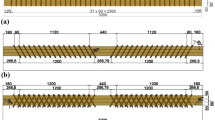Abstract
Timber as a structural material has experienced a revival for aspects related to sustainability, positive effect on interior building and increased architectural possibilities. To overcome a series of limitations related to partly obsolete traditional techniques, timber engineering sets high expectations on adhesive bonding as a joining method. Research on adhesively bonded timber joints has proven their superiority over mechanical fasteners in terms of strength and stiffness. Research on methods to design adhesively bonded timber joints under static loads is currently ongoing and significant progress has already been achieved. The topic of fatigue behaviour, however, has only been addressed very rarely, largely because “classical” methods for fatigue assessment based on Woehler curves, is extremely time-consuming. This paper aims to fill this gap by describing and validating an advanced time- and cost-efficient approach to quantify the behaviour of bonded timber joints under fatigue. Therefore the fatigue behaviour of beech wood as base material and adhesively bonded beech wood joints as structural elements were investigated by means of a short-time procedure. In this approach, cyclic tests with a stepwise increase of the stress amplitude were performed while the plastic strain amplitude was measured. The plastic strain amplitude gives reliable signals for an estimation of the fatigue strength. This is validated by traditional cyclic tests with constant stress amplitudes. It could be shown that the testing approach provides reliable results and has a high potential in time and cost savings for wood and adhesively bonded wood joints.






Similar content being viewed by others
References
Bodig J, Jayne BA (1982) Mechanics of wood and wood composites. New York, Van Nostrand Reinhold, ISBN 0442008228
Bond IP, Ansell MP (1998) Fatigue properties of jointed wood composites. J Mater Sci 33:2751–2761
Bonfield PW, Ansell MP (1991) Fatigue properties of wood in tension, compression and shear. J Mater Sci 17:4765–4773
Clorius CO, Pedersen MU, Hoffmeyer P, Damkilde L (2000) Compressive fatigue in wood. Wood Sci Technol 1:21–37
Estévez J, Otero D, Martín E, Vázquez JA (2010) The use of adhesive bulbs in the inner end of drills in order to improve the axial strength of steel threaded bars glued in timber. In: World conference of timber engineering (WCTE), Riva del Garda. 20–24 June 2010
ISO 12107 (2003), Metallic materials: fatigue testing: statistical planning and analysis of data. International Organization for Standardization, Geneva
Kamiński M (2002) On probabilistic fatigue models for composite materials. Int J Fatigue 24:477–495
Kuech W (1942) Finite-life and long-life fatigue strength of laminated wood (in German). Holz Roh Werkst 2–3:69–73
Kyanka GH (1980) Fatigue properties of wood and wood composites. Int J Fract 16–6:609–616
Sieminski R (1960) On the fatigue resistance of pine wood (Pinus silvestris) (in German). Eur J Wood Wood Prod 10:369–377
Tannert T, Vallée T, Hehl S (2012) Experimental and numerical investigations on adhesively bonded timber joints. Wood Sci Technol 46:579–590
Vallée T, Tannert T, Murcia J, Quinn D (2010) Influence of stress reduction methods on the strength of adhesively bonded joints composed of brittle adherends. Int J Adhes Adhes 30:583–594
Vallée T, Tannert T, Hehl S (2011) Experimental and numerical investigations on full-scale adhesively bonded timber trusses. Mater Struct 44:1745–1758
Walther F (2014) Microstructure-oriented fatigue assessment of construction materials and joints using short-time load increase procedure. MP Mater Test 56(7–8):519–527
Walther F, Eifler D (2007) Cyclic deformation behavior of steels and light-metal alloys. Mater Sci Eng A 468:259–266
Walther F, Eifler D (2008) Short-time procedure for the determination of Woehler and fatigue life curves using mechanical, thermal and electrical data. J Solid Mech Mater Eng 2:507–518
Author information
Authors and Affiliations
Corresponding author
Rights and permissions
About this article
Cite this article
Myslicki, S., Vallée, T. & Walther, F. Short-time procedure for fatigue assessment of beech wood and adhesively bonded beech wood joints. Mater Struct 49, 2161–2170 (2016). https://doi.org/10.1617/s11527-015-0640-4
Received:
Accepted:
Published:
Issue Date:
DOI: https://doi.org/10.1617/s11527-015-0640-4




